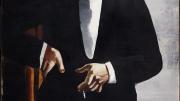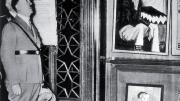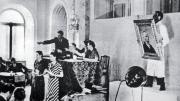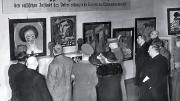Thomas professor of history of art and architecture Joseph Koerner, an affiliate of the department of Germanic languages and literatures and a senior fellow of the Society of Fellows, spoke last April at a Radcliffe Institute conference on the “University as Collector.” At Harvard Magazine’s request, he revised and extended his remarks into the following essay.
~The Editors
Max Beckmann’s Self-Portrait in Tuxedo hangs in the newly renovated, combined Harvard Art Museums at the focal point of the architectural vista into the Busch-Reisinger Museum galleries, establishing—visibly and physically—an identity for this discrete institution within this triad of museums. The curators’ decision makes obvious sense. That painting is, after all, the Busch-Reisinger’s most famous work, the object most often requested for loans. It’s also an “iconic” work, to use that much-overused word. It’s iconic of the Busch-Reisinger. It’s iconic of its maker, Max Beckmann. It’s iconic of the artistic movement called Expressionism. And it has become iconic of the Weimar Republic, and therefore of a decisive era in the history of Germany and of the Europe centered on, and unsettled by, Weimar Germany.
In the Busch galleries in their current installation, Beckmann’s canvas presides over an art historical trajectory that goes (roughly) from Viennese modernism via German Expressionism to the Bauhaus. Thus its placement also makes sense because, for almost everyone, Beckmann and the German Expressionist movement are an important climax within the history of European art, because, internationally, German art is felt to have only two great high points: one during the early sixteenth century, in the art and the era of Albrecht Dürer; the other in the early twentieth, in the art of Franz Marc, Käthe Kollwitz, Ernst Ludwig Kirchner—and Beckmann.
From afar, in fact, the work looks less like an artist’s self-portrait than like one of those official portraits you see at the entrance to single-collector museums such as the Thyssen-Bornemisza Museum, where the donors preside permanently over their holdings in the form of life-size painted likenesses. That is, Beckmann looks less like a painter than like a patron, perhaps like the beer magnate Adolphus Busch, after whom the Busch-Reisinger Museum was partly named. Indeed one critic, writing in 1927 when the canvas was painted, noted that Beckmann had painted himself to look like a “young baron of industry.”
To do justice to the impact of this person, this persona, you really have to stand before the picture, or better yet, lead a discussion with friends or students in front of it. But I’ll suggest a few obvious aspects of the work.
One of the features that makes the painting so visually compelling is the casualness with which the sitter—Beckmann—confronts us, with one hand on his hip, the other holding the cigarette ready, the two hands bringing the body together at its center. This man (the setup tells us) can stand here a long time; the cigarette even gives him something to do. Probably nowadays, because he wouldn’t be allowed to smoke in the galleries, he’d be holding his cell phone so that he could see the screen. But he’s not smoking his cigarette or checking his phone: he’s looking at us. And that is the other incredible feature of the painting: this confrontational relationship to the viewer.
The painter’s relation to us is too direct and too intimate to be friendly. His frontal gaze has almost an aggressive character. And as anyone who paints will know, it’s very hard to paint a frontal likeness of someone convincingly. The look of a face is better captured slightly from the side, in what’s called a three-quarters view, where the outlines of the nose and the shape of the forehead, cheeks, and chin are clarified. Frontality is natural to self-portraiture, because the painter looks straight at the mirror. But in Beckmann’s hands, the frontal view gives rise to a highly complex image of the human face, as we’ll see.
The last feature I want to point out are the artist’s clothes, that black tuxedo which makes everyone, as they enter the gallery, feel a little bit underdressed in comparison—unless, of course, you are lucky enough to be at some museum opening and wearing a tuxedo, too. But even then, Beckmann will be there before you, and seem more at ease. And in how he stands and where he’s chosen to stand, it’s also clear that he can leave, that he can move out the door just to his right. Again, the sense that he belongs here, that he knows better than you how to dress and what to do, gives the impression that you aren’t an audience viewing him, but that he is giving you an audience instead.
He belongs, we don’t, or don’t so well as he. What better image for the Busch-Reisinger to station front and center in its galleries than this picture that seems so much to belong. But the tuxedo also signals a certain kind of belonging. The great Viennese critic and architect Adolph Loos captured this in his commentary on men’s clothing. He said that an article of dress is modern if, “when wearing it on a particular occasion in the best society at the center of one’s culture, one attracts as little attention as possible to oneself.” Loos wrote this in 1898, and what he meant is that somehow one should disappear into the woodwork, but only at the center of society—which for him meant high society in London or in New York. Loos noted, amused, that if you actually showed up in Vienna at the time wearing casually fitting London or New York attire, you would stand out, or be laughed at, because the Viennese were still provincial or backward in their dress. Their elegance would stand out in London, but it also stood out in Vienna, as it was local and exaggerated. Loos was saying that to become cosmopolitan was to disappear into one’s surroundings, and that to do this was the mark of being a modern person. Modern persons don’t display themselves as individuals through their clothing. They choose instead to vanish into the crowd—perhaps to distinguish themselves elsewhere, through art or commerce.
Max Beckmann wrote something similar about 30 years later, in 1927, in an essay exactly contemporary with the painting. He said that the new priests at the center of culture must be dressed in dark suits, or on state occasions must appear in tuxedo. By priests, Beckmann meant the creative artists, and their religion was one in which God was finally discovered to be nothing more nor less than a human being. The artists are priests of this new religion because they are shapers, and what they shape is identity. They shape identity not as merely a physical image of a person, but in the very way they shape: the form that his painting takes is the identity that the painter makes not just for himself but for the whole of society.
So why the tuxedo? Because, Beckmann argues, a tuxedo is specifically what you wear at an “occasion of state.” So that is what he’s doing in that tuxedo. He is at an official event: the moment of the shaping or new formation of the state, a shaping or formation that the artist himself accomplishes by the way he paints and the way he is. From his text, we can glean, further, that the new kind of state Beckmann is imagining is a European state balanced between powers—hence the formal balance of the painting’s composition. The whole picture is that programmatic! The new state should also be centered, rather than fragmented and localized; it should be like the centered body of the artist, but not by having any single capital, say, in Paris, London, Vienna, or Berlin. Rather, it should be centered in the person—in the modern individual—and should therefore be not a polis but instead a cosmopolis.
The self-portrait, then, is a great object for the Harvard Art Museums, that cosmopolitan gathering of all the world’s art. But how did it come to be in the Busch-Reisinger, a collection that (compared to the Fogg) has to do with a more local geographic and cultural identity?
As it happened, the University acquired the painting in 1941, at a moment that could not have been less cosmopolitan, indeed the most violently riven moment of the twentieth century, after France had fallen to Germany and on the eve of the U.S. entry into World War II.
Why did the Busch acquire this German picture at that time? Very briefly, Beckmann’s Self-Portrait in Tuxedo was adored by critics when it was first exhibited in 1927. Immediately, it was understood to be a representation of a new persona, a new mask: a persona or mask for the “modern” person, a being who was of the time—modern in the sense Baudelaire meant when he wrote of “modernity” and of painters of “modern life. ” Critics understood, and Beckmann in his writings explained, that this new person, this new persona presented in the painting, was a balanced self, a self internally balanced in itself, and therefore mobile in every sense. Much praised and much discussed, the painting was immediately acquired by the novelist and art critic Julius Meier-Graefe. It then came to the National Gallery in Berlin, where it was given its own room—so it was at least as important a painting when it was painted as it is today.
Then Hitler came to power in 1933, and institutions came under party control—especially institutions of culture, because the Nazis deemed their movement a cultural revolution. And at that moment, the enemy that had to be vilified and destroyed, in their view, was precisely the modern, modernist artist. Most changes were immediate, though it took some years for this antagonism to reach its final form. In 1937, it took the terrifying shape of an exhibition of “Degenerate Art” (entartete Kunst).
For me, that exhibition is a teaching moment par excellence about art collecting, because artists’ works were gathered in order to be mocked, slandered, and destroyed. In German, the adjective entartet has a much more racist meaning than “degenerate.” Derived from the noun Art (meaning kind, species, or race) plus ent- (meaning a reversal or conversion into its opposite), entartet conveyed the idea that culture had become degenerate, was no longer what it should be, because of troubles with species or race. The racial problem was the intermingling of races, and particularly the introduction of a foreign, Jewish, component into German culture.
The imagined Jewishness of modern art degenerated art by making it no longer of its kind; instead of being local (the expression of a people or volk), it became global (the expression of the false collectivity of “all peoples”). Global meant mobile, nomadic, rootless: it was this rootlessness that was identified with modern painting and modernity and that the exhibition held up for ridicule. Pressing original artworks and mock slogans together in a wild collage, the show turned the aesthetic of Expressionism against itself.
There are reports that people were expected to laugh loudly while they passed through the galleries; otherwise they might be suspected of liking the art and sympathizing with the enemy. In fact, in many photographs of the heavily attended exhibition, it is hard to tell who was for the exhibition and who was against it, who went to hate the art and who went silently to say goodbye to the art they loved.
A page from the exhibition catalog says it all by saying nothing: “All commentary is superfluous”—meaning that the five sculptures reproduced are somehow self-evidently repugnant. This is an amazing moment for art historians: it shows that sometimes commentary is urgently needed. It is needed, for example, when we see in one of the photographs from the exhibition a work that now hangs in the galleries of the Busch. It is especially needed when that work is The Mulatto, by Emil Nolde, an artist who held political and racist views similar to those of the exhibit organizers, but who was (to his complete surprise) vilified by them and exhibited as an enemy.
After the exhibition, the works gathered and displayed were deaccessioned from public collections and destroyed or sold. The Self-Portrait that Van Gogh dedicated to Paul Gauguin, along with Beckmann’s Self-Portrait, Nolde’s Mulatto, and several other key works were auctioned, and eventually made their way to Harvard.
This doesn’t explain why Harvard bought the Beckmann. Originally, the Busch-Reisinger Museum contained plaster casts and photographs. Founded in 1903, it was supported by Kaiser Wilhelm II himself and intended to foster a sense of German identity among German Americans who (it was felt) shed their ethnic identity in the New World more rapidly than other immigrant groups. The museum’s opening was ill-fated. World War I began barely a decade later, making celebrations of Germanness for a time unthinkable in the United States. By the time World War II broke out, however, another identity had been found not only for the Busch, but also for the Fogg: instead of collecting reproductions (casts and photographs), they collected original works of art.
Beckmann’s Self-Portrait in Tuxedo is, in fact, the first modern work of art the Busch ever purchased. And what a strange and amazing beginning, to have this work, of all things, effectively purchased, polemically, as representative of a Germany “other” than Hitler’s: a cosmopolitan and thus not quite German Germany of men wearing tuxedos, a Germany now exiled from its own country, but becoming a potent symbol of that country, defining the country in exile as still potentially devoted to a cosmopolitan ideal.
This vexed provenance makes the Beckmann fitting for a museum that has itself been repeatedly called upon to redefine its identity. (This gives the Busch an advantage over the Fogg, which has always treated its identity in a cosmopolitan fashion, as a neutral thing.) But all this backstory would be of little interest were it not that so much of what I’ve said is contained and outdone, transcended, made problematic, made visual, made visible, made speakable, by the painting itself.
One can learn about the balance of power and about painting and politics just by looking at how Beckmann paints his thumb, or how the whole frontal representation of the body is, as it were, negotiated, or crossed out, by the radical splitting of the body into two parts, the black and the white, a splitting that goes right through the sitter’s face. This is an incredibly counterintuitive move, to place at the center of a face, your own face, this fragmenting device of shadow and light, of chiaroscuro that doesn’t unite the composition and or set forth the body but rather fragments and distorts. But what better emblem of the attempt to belong and at the same time to be always moving elsewhere, to be at home and at the same time be in exile?
That one painting can do this, and do this in a university setting, with classes grouped around it and countless discussions provoked by it, is extraordinary. More extraordinary still is that, all during the classes and discussions, that painted cigarette still seems to burn, making us feel that the picture is happening right now, and that its modernity is therefore still with us. I think this goes some way toward answering what and why a university should collect: that this one little bit of an artwork—a bit of lead white paint standing for ash—can provoke some of the deepest questions imaginable.













